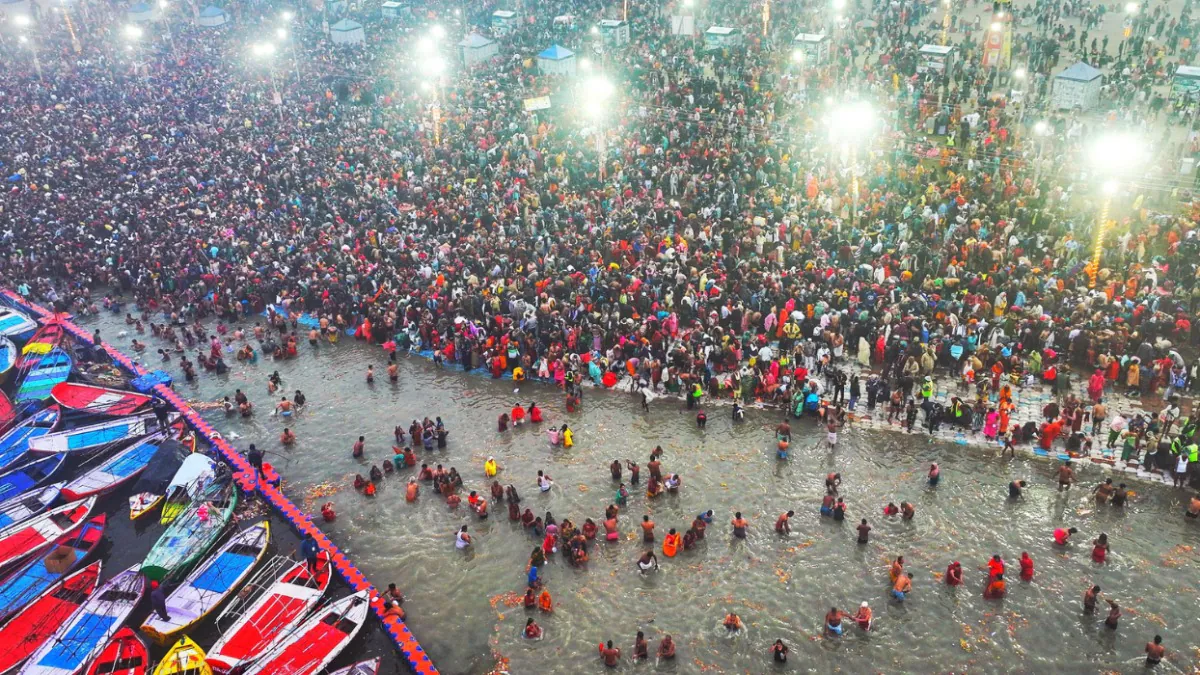Maha Kumbh Mela is a grand and sacred festival and it is one of the largest religious gatherings on earth. It is celebrated in India and in this significant festival millions of devotees, ascetics, and tourists from around the world gather to take bath in the holy waters of the rivers where it is celebrated. Let’s explore what Maha Kumbh mela is, its origin story, the places where it is celebrated, and the benefits of bathing in its holy waters.
Table of Contents
What is Maha Kumbh?
Maha Kumbh Mela is a Hindu pilgrimage that occurs once every twelve years at four river-bank pilgrimage sites: Prayagraj, Haridwar, Nashik, and Ujjain. The festival’s name is derived from the Hindu tradition of Kumbh, which signifies a pitcher, symbolizing abundance and immortality.
The core of Maha Kumbh mela lies in the ritual of bathing in sacred rivers. Devotees believe that taking a dip in the holy waters during the Kumbh Mela purifies the soul, washes away sins, and liberates one from the cycle of birth and death. This act of spiritual cleansing is the highlight of the festival, attracting millions of people to the banks of the rivers Ganga, Yamuna, and the mythical Saraswati.
To know which day of the week is dedicated to the worship of which god, please read our article here.
The Origin Story of Maha Kumbh

The origins of Maha Kumbh Mela are steeped in ancient Hindu mythology. According to legend, the gods (Devas) and demons (Asuras) were once engaged in a fierce battle for supremacy. To attain immortality, both parties agreed to churn the ocean of milk (Samudra Manthan) to extract the nectar of immortality (Amrit).
The churning of the ocean was a monumental task, requiring the combined efforts of both the gods and demons. Mount Mandara was used as the churning rod, while the serpent king Vasuki served as the rope. As the churning progressed, various divine objects emerged, including the Amrit.
Fearing that the demons would gain control of the nectar and become invincible, the gods sought the assistance of Lord Vishnu. In the guise of the enchantress Mohini, Vishnu distracted the demons and seized the Amrit. In the ensuing chase, drops of the nectar fell at four locations: Prayagraj (Allahabad), Haridwar, Nashik, and Ujjain. These sites are now considered sacred, and it is at these locations that the Maha Kumbh Mela is held.
There is another popular similar story in which the son of Indra ran away with the pot of nectar to protect it from demons and during his run, few drops fell at four places and these are the places where we celebrate Maha Kumbh mela today.
If you are looking to buy authentic, premium and aromatic incense, or hawan cups for your daily puja rituals, consider buying our products by clicking this link.
Places Where Maha Kumbh is Celebrated

Maha Kumbh Mela is celebrated at four major locations, each holding profound religious and historical significance:
Prayagraj (Allahabad): Prayagraj, located in the northern state of Uttar Pradesh, is considered the holiest of the Kumbh sites. It is believed that the confluence (Sangam) of the Ganga, Yamuna, and the mythical Saraswati rivers is especially auspicious. The MahaKumbh at Prayagraj attracts the largest number of pilgrims and is known for its grand scale and elaborate rituals.
Haridwar: Haridwar, situated in the state of Uttarakhand, is another key site for the Maha Kumbh. The city is located on the banks of the Ganga river, where it descends from the Himalayas. Haridwar is renowned for its Ganga Aarti, a daily ritual of offering prayers to the river. During the Maha Kumbh, the city transforms into a spiritual hub, drawing millions of devotees and saints.
Nashik: Nashik, located in the western state of Maharashtra, is celebrated for its association with the Godavari river. The city is known for the Trimbakeshwar temple, one of the twelve Jyotirlingas (sacred shrines of Lord Shiva). The Maha Kumbh in Nashik is marked by rituals, processions, and spiritual discourses, making it a significant event for devotees.
Ujjain: Ujjain, in the central state of Madhya Pradesh, is associated with the Kshipra river. The city is home to the Mahakaleshwar temple, another Jyotirlinga, and has a rich cultural and religious heritage. During the Maha Kumbh, Ujjain becomes a vibrant center of devotion, with pilgrims flocking to the banks of the Kshipra for the holy dip.
Among these four cities, Prayagraj and Haridwar also celebrates ardh-kumbh which is celebrated after every 6 years.
The Benefits of Bathing in Maha Kumbh

Bathing in the holy waters during Maha Kumbh Mela is believed to offer numerous spiritual benefits:
- Taking a dip in the sacred rivers is believed to purify the soul, cleanse one’s karma, and absolve sins accumulated over lifetimes. This spiritual cleansing is thought to bring devotees closer to moksha, or liberation from the cycle of birth and death.
- The holy dip is believed to invoke the blessings of the divine, providing protection, prosperity, and spiritual growth. Pilgrims often feel a deep sense of peace and contentment after performing this ritual.
- Some believe that the mineral-rich waters of the sacred rivers have healing properties, promoting physical well-being and rejuvenation. The act of bathing in these waters is considered to have a therapeutic effect on the body and mind.
- The act of bathing alongside millions of fellow devotees fosters a sense of unity, equality, and brotherhood. The shared experience of devotion and faith brings people together, transcending social and cultural boundaries.
MahaKumbh 2025 promises to be a spiritually enriching experience, bringing together people from different walks of life in a quest for purification and enlightenment. The festival’s deep-rooted traditions, mythological origins, and the holy sites where it is celebrated make it a unique and revered event. As millions gather to participate in the Maha Kumbh mela, they reaffirm their faith, seek divine blessings, and celebrate the timeless essence of spirituality.







